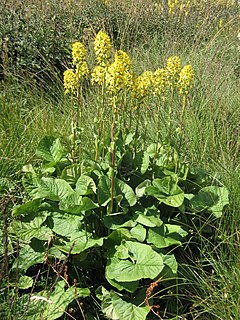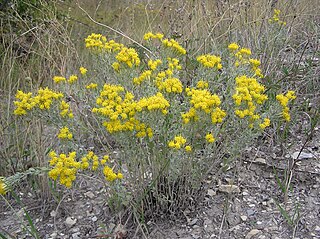
Senecio is a genus of flowering plants in the daisy family (Asteraceae) that includes ragworts and groundsels.

Tanacetum is a genus of about 160 species of flowering plants in the aster family, Asteraceae, native to many regions of the Northern Hemisphere. They are known commonly as tansies. The name tansy can refer specifically to Tanacetum vulgare, which may be called the common tansy or garden tansy for clarity.

Brachyglottis is a genus of flowering plants in the family Asteraceae. The genus was erected on November 29, 1775, by Johann Reinhold Forster and Georg Forster. The name was derived from the Greek brachus ("short") and glottis a reference to the size of the ray florets.

Farsetia is a genus of flowering plants in the family Brassicaceae. It contains the following species:

Senecio leucanthemifolius is a plant common in sea-side in Mediterranean area.

The genus Cacalia L. is a nomen rejiciendum under the International Code of Nomenclature for algae, fungi, and plants. The type species C. alpina L. has been transferred to Adenostyles alpina (L.) Bluff & Fingerh., and the former species of Cacalia now reside in a few different genera.
Plantago amplexicaulis is an annual plant of the family Plantaginaceae and the genus Plantago that grows in dry sand and deserts.

Forsskaolea is a small genus of 6 species of perennial herbs in the nettle family with non-stinging hairs and dot-like concretions of mineral matter on their green parts. The genus was named in honor of Swedish botanist Peter Forsskål.

Jacobaea adonidifolia is a species of the genus Jacobaea and the family Asteraceae.

Jacobaea gibbosa is a species of the genus Jacobaea and the family Asteraceae.

Doronicum corsicum is a species of the genus Doronicum and the family Asteraceae. some authors have regarded the species as belonging to either Arnica or Aronicum. It is a rare plant that has been found only on the Island of Corsica in the Mediterranean.

Ligularia sibirica is the type species for the genus Ligularia. It is a 0.3-1.3 m tall perennial herbaceous plant, native to fens and damp grassy meadows in Siberia, Central and Eastern Europe. Once fairly common, it has disappeared from many places in Europe, owing to drainage of wetlands and competition from other plants invading its natural habitats; when growing in shade plants do not flower or set seed very well and seed germination is greatly reduced. This species is sometimes grown in gardens for its large leaves and tall spike like arrangement of yellow daisy like flowers.
Crinitaria is a genus of flowering plants in the daisy family. Three species are accepted:

Galatella is a genus of flowering plants in the daisy family, native to Europe, Asia, and northern Africa.

Caucasalia is a genus of flowering plants in the daisy family.

Dolichorrhiza is a genus of flowering plants in the sunflower family.
Iranecio is a genus of flowering plants in the sunflower family, native to the eastern Mediterranean east to the Caucasus.
Ligulariopsis is a genus of flowering plants in the groundsel tribe within the sunflower family.
Pojarkovia is a genus of flowering plants in the sunflower family.














